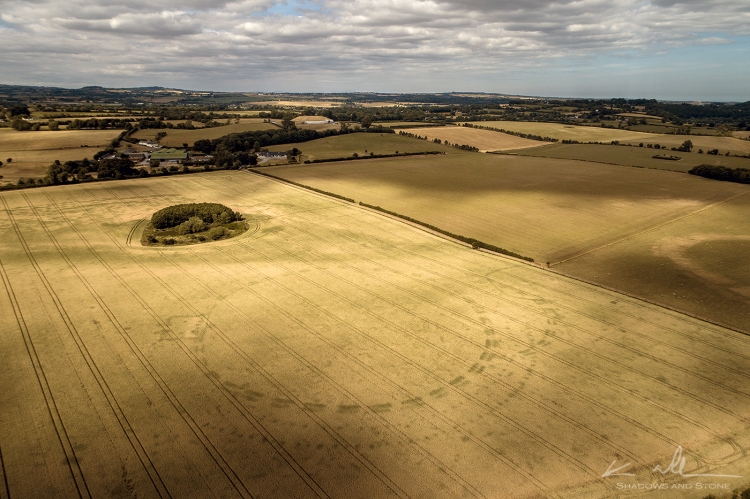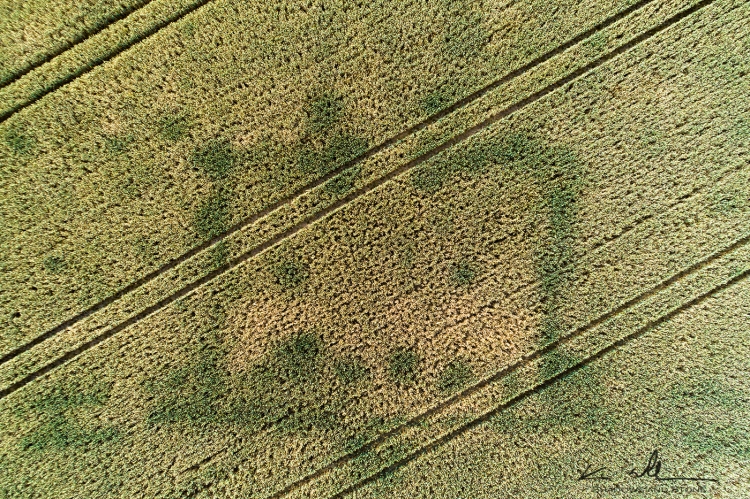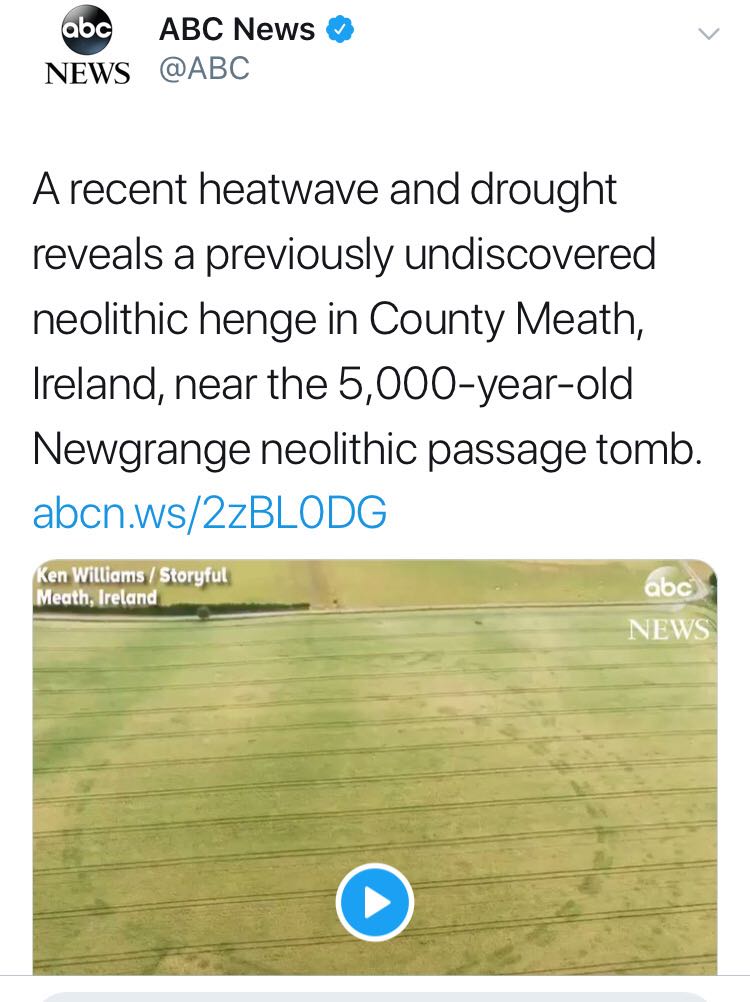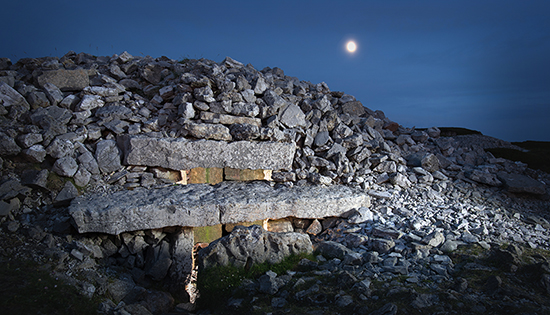
On Tuesday evening, 10th of July, 2018 I was at the great passage tomb of Newgrange, Co. Meath, with Clare Tuffy, manager of Brú na Boinne. I’ve been to Newgrange countless times but the site is so complex and intriguing, each visit continues to offer new insights and observations. I had in mind to take some photos of the kerbstone art and afterwards to take a few aerial shots, including the very exciting excavation being carried out by Geraldine and Matthew Stout in the field below the mound. The features uncovered by geophysical survey there are truly extraordinary.
Clare and I had been working out a time and date to meet at the site and when I couldn’t make it on Monday evening Clare said Tuesday evening actually suited a lot better anyway. What followed was a series of startling and fortuitous coincidences that would in turn lead to several enormously significant discoveries.
Leontia Lenehan from the Brú na Bóinne Visitor Centre had noticed that one of the small stones in the rear revetment of the cairn might have some picked carving on it. Clare and I went to investigate. While doing so, I stumbled on the first extraordinary find of the day. The stones in the area Leontia indicated appeared to have entirely natural surfaces but there was something highly unusual within that tiny, specific section of the revetment that had never been noticed before. More on that, hopefully, at a future date.
Just after Clare and I left Newgrange I bumped into Anthony Murphy of Mythical Ireland who was also preparing to take some aerial photos of the area. I’ve known Anthony for years and we have both been active amateur researchers, documenting the Brú na Bóinne landscape and monuments since the early 2000s. Anthony is also a great writer and photographer, alongside being involved in music, astronomy, amateur radio and several other active interests. We are also both incurable camera geeks and often spend entire evenings discussing the technical merits of a wide range of Nikon cameras and lenses. Anthony has always been generous with his time, knowledge and equipment and has saved the day on more than one occasion when I was stuck. You can read Anthony’s account of the new finds on his own blog here.
Dr. Steve Davis, assistant professor in Archaeology in UCD, who has been poring over the aerial photography and LiDAR of the Brú na Bóinne landscape for years, had already suggested to each of us separately that the extremely dry weather conditions for the past few weeks were ideal for capturing the existing features visible in the LiDAR data but normally not seen from above. There was even the potential for finding some new sites. There was absolutely no hint or any expectation however of discovering features that would go on to make global headlines.
Typically we spend hours minutely examining photos of ambiguous markings that could be something, but are more than likely nothing of archaeological significance. They are usually impossible to give any definite classification or dating to.
Anthony and I both fly DJI drones, so after we started to survey the landscape there was some unusual interference on our screens causing the displays to break up. I moved further away to try and reduce the interference and within minutes Anthony was shouting and calling me over to look at his screen.
What we were looking at seemed too good to be true. At first I thought it might be some strange artifact of the screen interference, the details of a circular feature in the crops below were so incredibly detailed. Maybe it was a crop circle made by pranksters? We moved in closer to look at it in detail, the we could see for certain that this was the colouration of standing crops that had not been interfered with. What we were looking at was beneath, within the soil, not in the crops themselves.
The combination of the type of crops in the field, the extreme dry weather over the preceding weeks and the fact that we were both flying over that area just as the differential colouration of the crops seemed to be peaking, all came together to make an incredible discovery.


Next to this spectacular feature was another, similar in appearance to the inner, segmented ditches visible in the first feature. Roughly in the centre of this was a circular feature with a pronounced ‘I’ shaped appearance. We both knew this was approximately the area where a probable passage tomb and henge had been revealed by LiDAR and geophysical survey, but it had never been visible to the unaided eye before this.
Up in the corner of the field I spotted more circular marks, on closer examination it was two concentric circles of pits or post holes with four much larger pit/post holes within it. Extending out from the outer circle there were two parallel lines of post/pit holes, like a short entrance avenue perhaps. The following morning, while looking at the photos in more detail I noticed it had a larger, circular henge-like enclosure around it. This feature looked very similar to the Late Neolithic wooden four-poster circles, associated with Grooved Ware pottery, uncovered in excavations at various important sites. The best presented example was reconstructed as it was found, close to the entrance of Knowth’s eastern passage. Another well defined circle of similar appearance was found at Ballynahatty, adjacent to the enormous banks of the henge known as ‘The Giant’s Ring’, south of Belfast in Co. Down.

Running past this is a set of two, very wide, parallel arcs of darker crops. It’s difficult to tell whether these arcs consist of narrow, continuous ditches or sets of very closely spaced posts. Across the same field, other features and anomalies of potential interest were readily apparent.

That night, Anthony and I spent several hours reviewing the photos and discussing the enormous significance of what we had found with Steve. Archaeologists are typically cautious about publishing early impressions about significant discoveries. Steve was advocating at least a few days of careful examination and surveying of the area before going public. Anthony, however, as a seasoned journalist and news editor, recognising the enormous significance and public interest in the discoveries, as well as the very likely discovery of the features by others flying drones or even in low-flying aircraft at any moment, decided there was no time to waste. There was every reason to go ahead immediately.
We both agreed it was, quite literally, too big a discovery to try to keep a lid on. If we didn’t go public then, someone else surely would in the following days. For all we knew it may already been spotted and posted online. From the air it resembles an impressive crop circle, though the obvious difference between crop circles and the features we saw is that crop circles are made by flattening the crops. That was not the case here.
What Anthony had spotted first was a Neolithic structure of such clarity and detail, with features unprecedented in the published literature. It is unquestionably the jewel among the other discoveries that followed, something of international importance. The other discoveries, while significant, are not unique in the archaeology of the Irish Neolithic, the segmented ditch features in the new henge however are surely a new class of monument altogether.

The following morning, I returned to the Boyne Valley early in the morning and while flying over the areas along the river, I noticed two large circular features in a field overlooking the river flood plain, on the south side of the river. One had earlier been recorded as an enclosure, but the new aerial photos indicated a very wide ditch, marked by dark crops, surrounded by a similarly wide bank, shown by lighter crops growing in significantly shallower soils. This strongly suggests it is a wide bank with a large internal ditch, a Late Neolithic henge, seemingly the first to be discovered south of the river in the Boyne Valley.
In the corner of the field, in a prominent position at the edge of a steep valley, was another horse-shoe shaped feature with a possible interior structure at its south end and a clearly defined opening to the north. These features are on the lands owned by the local company Newgrange Gold, who were delighted to see the video of these features shown in the national news bulletin on RTÉ News.

Further east, on the lower levels of the Boyne floodplain beside the probable passage tomb known as ‘Mound B’, two other enormous circular features came into view. Later, while sharing some photos with Steve, I learned that one of these was a probable henge that was strongly hinted in the LiDAR data, the similarly sized example next to this, however, had not been seen in previous investigations of the area.

Over the next couple of days I went on to document several other, smaller sites of probably later periods in the Co. Meath area which will now be reported to National Monuments.
Some facts and figures for the monuments first revealed:
The large, elaborate henge of post holes and segmented ditches:
It is approximately 150m in diameter.
The interior space is 120m in maximum diameter.
The rectangular entrance or exit structure on the western side of this henge is about 230 square metres in size, quite an enormous structure in its own right.
Its nearest edge is 638m from the kerb of the great passage tomb of Newgrange.
Its closest edge is approximately 63m from the water’s edge along the Boyne.
The new henge is 83m from the edge of the known site, LP2.
The four-poster wooden concentric circle in the north east of the field:
The outer wooden circle is approximately 32m in maximum diameter. The reconstructed example from Knowth in my video above, by comparison, is about 8.5m in diameter.
The inner wooden circle is approximately 19m in diameter.
The large wooden posts that make up the ‘four-poster’ were about 9m apart.
The two parallel rows of posts which seem to make up a short entrance avenue are also 19m long, as far as we can tell from the photographs.
The circular henge-like enclosure around it seems to have been around 90m in diameter but is now partially under roads.
The outer wooden circle is approximately 400m south west of the kerb of Newgrange.
The finds have since been reported on in the media across the globe, featuring on ABC News, The Washington Post, The New York Times, Al Jazeera, El Pais, The BBC, RTE News, Today FM, Newstalk FM and many other news outlets.


On Friday the 13th, the National Monuments section of the Department of Culture, Heritage and the Gaeltacht visited the site and surveyed the area from a helicopter, gathering more images. On Sunday they issued a press release, announcing further significant finds in the area.


Good to get the details of this extraordinary discovery.
Thanks Finola!
A once-in-a-lifetime find for you both. Great to get the exact story from both yourself and Anthony. Congratulations!
Thank you Becks!
Great discovery by Anthony and you and a high level of cooperation with all concerned. Well done. It is bizarre that such important landmarks were not spotted before. Is funding for archaeological digs an issue?
Hi Sean and thanks! The area has been minutely analysed using LiDAR and targeted geophys surveys, there was a very detailed report issues by the INSTAR team in 2010 I think. The monuments that showed up are just ghosts of former timber structures, the only traces of them are the slight differences in soil depth and composition at the spots where pits and timber posts once were. The post holes might be a metre or more underground so very difficult to spot without excavation.
Congratulations to you both on this incredible find!
Thanks Jo!
Fantastic find, keep up the good work!
Thanks!
Congratulations on your tremendously exciting discovery!
What a momentous occasion!
It would seem years of earnest interest and study are well rewarded.
I’m really impressed by the professionalism and respect of all parties.
Keep up the good work.
Congratulations again from a Meath-man, now in New Hampshire!
Thank you John! It is exciting to think that an area you thought you knew like the back of your hand could be hiding secrets as large as this.